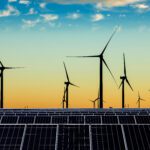UN Report on Global Renewable Energy Investment. The United Nations Environment Program (UNEP) released its report Global Trends in Renewable Energy Investment 2013 on June 11, finding that renewable energy investment at the global level was $244 billion in 2012. However, global investments in renewable energy fell 12% compared to 2011 due to dramatically lower solar prices and weakened U.S. and European markets, the report notes. An upward trend is also noted in developing countries. Total renewable power capacity worldwide exceeded 1,470 GW in 2012, up 8.5% from 2011. Wind power accounted for about 39% of renewable power capacity added, followed by hydropower and solar photovoltaics (PV), which each accounted for approximately 26%.
In 2012, the world’s total solar PV capacity reached the 100-GW milestone, surpassing biomass power to become the third-largest renewable technology in terms of capacity in operation, after hydro and wind. Investment in solar plunged, however, owing to a fall of 30% to 40% in PV system prices. Lower costs spurred bigger investment in small-scale solar, rising from $77 billion in 2011 to $80 billion in 2012 while spending on large-scale solar projects of more than 1 MW fell to $52.7 billion.
China alone poured $67 billion into renewables development, and sharp increases are noted in South Africa, Morocco, Mexico, Chile, and Kenya, with the Middle East and Africa showing the highest regional growth. Japan’s renewable investment also soared to $16 billion from a boom in small-scale solar on the back of its July 2012-implemented feed-in tariff subsidies. In the U.S., which was the market leader in 2011, investment fell 34% to $36 billion on policy uncertainties, while investment in Italy and Spain was also hit by concern about future support for the sector. Germany’s overall investment in renewables slipped 35% to $20 billion, stemming from the lower solar cost and a drop in wind power investment.
Canada to Increase Nuclear Liability Limits. Canada’s Ministry of Natural Resources on June 10 announced the country would proceed with increasing liability limits for its nuclear industry “above most international standards.” The proposed new legislation that could make nuclear generators “absolutely and exclusively” liable for nuclear damage would increase the amount of compensation available to address civil damage from C$75 million to C$1 billion. Replacing legislation that is almost 40 years old, the bill that will be debated in Parliament this fall is also expected to broaden the number of categories for which compensation may be sought and improve procedures for delivering compensation. Canada also said it intends to join the International Atomic Energy Agency’s Convention on Supplementary Compensation for Nuclear Damage. The country whose nuclear power sector produces about C$5 billion in annual revenues is also overhauling its nuclear regulatory system and restructuring Atomic Energy of Canada Ltd.
Adani Power Starts Third Supercritical Coal Unit. Ahmedabad-based Adani Power on June 19 commissioned the third 660-MW unit of its supercritical power plant in Tiroda, Maharashtra, India. When completed, the project—Maharashtra’s biggest power generation facility—will have five units for a total of 3.3 GW. The first two 660-MW units were commissioned last year, and the third unit was commissioned within a record 20 days from synchronization (the industry standard is three months), Adani Power’s parent Adani Group said. Adani Power last year put online India’s largest private high-voltage direct current power transmission system, which connects the recently completed 4.6-MW coal-fired Mundra power plant in Gujarat to power-strapped northern India. The 500-kV project runs a distance of 1,000 km and has a transmission capacity of 2.5 MW.
Siemens, Statkraft Start Knapsack II Combined Cycle Plant. Siemens Energy on June 13—six weeks ahead of schedule—completed the 430-MW Knapsack II combined-cycle power plant near Cologne, Germany, for Statkraft Markets GmbH, a subsidiary of the Norwegian utility company Statkraft. The single-shaft unit, which boasts an efficiency of 59.2% was completed as a turnkey project. It includes an F-Class turbine as well as a steam turbine generator and heat recovery steam generator. A natural gas supply line from a connection point in Wesseling to the location of the power plant in Hürth-Knapsack with a length of 13.2 km was laid to make the operation of the power plant possible. The short run-up and shutdown times make the power plant ideally suited to compensate for the fluctuating feed-in of renewables, Siemens said. Statkraft has said, however, that it is constantly reevaluating the economic viability of gas-fired projects in Germany, noting that profitable capacity utilization of efficient gas plants is under significant pressure due to high natural gas prices and increased renewables generation.
DONG Energy to Sell Onshore Wind, Hydro Business. Danish firm DONG Energy could sell its onshore wind business in Denmark to energy firm SE and Danish pension fund PFA for $132 million under a June 25 agreement. The divestment concerns a total of 272 wind turbines (a total nameplate capacity of 196 MW) located at about 80 different sites in Denmark and with an average operational track record of 16 years. DONG Energy in late June also signed an agreement with Voimapiha AB, a consortium consisting of the three Finnish energy companies Kymppivoima, EPV Energy, and Helsingin Energia, under which Voimapiha AB will acquire DONG Energy’s entire ownership stake of 25.673% in the Swedish hydro power company Kraftgården AB. Kraftgården AB owns and operates seven hydro power plants along the Swedish river Indalsälven, with a total capacity of 626 MW. The measures follow DONG Energy’s February announcement that it would divest non-core assets of a $1.74 billion value between 2013 and 2014 and that its wind power business will focus on offshore wind in the future.
—Sonal Patel is POWER’s senior writer.








